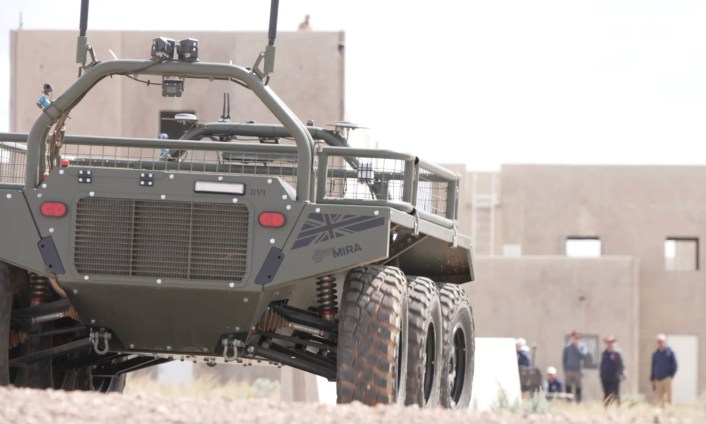The AUKUS trilateral security partnership has successfully tested defense autonomous ground robotics, marking a potentially significant step forward in integrating robotic technologies into the grouping’s collaborative defense strategies.
Breaking Defense reported this month that AUKUS defense officials have completed a robotic trial in what it termed a “congested electronic warfare (EW) environment.” AUKUS is comprised of the US, UK and Australia and is geared largely toward challenging and countering China’s rising assertiveness in the Indo-Pacific.
The Trusted Operation of Robotic Vehicles in a Contested Environment (TORVICE) trial took place in South Australia in the autumn of 2023 and was designed to observe how autonomous ground vehicles would react under attack from EW weapons.
The TORVICE trial was conducted by US Army and Australian defense officials who have previously cooperated on such efforts. It mentions that a network of robotic ground vehicles from the UK and US were configured to represent autonomous multi-dome launchers and uncrewed ground vehicles conducting long-range precision fires and associated missions. The vehicles carried no weapons during the trial.
Janes mentioned in an article this month that the TORVICE trials ran from September 4-5, 2023, and involved two UK IDV Robotics Viking vehicles and two US Ford Raptors with a US-developed autonomy system. The vehicles were then subjected to attacks from electronic warfare, electro-optical lasers, position, navigation and timing systems to test resilience, the Australian government said in a statement.
“Robotic and autonomous systems have the potential to transform the battlefield providing a force multiplier while reducing risk to warfighters… TORVICE allows us to understand robotic autonomous systems’ operation in a contested environment and increase resilience of these systems. Working across three nations will accelerate development of robust capable systems,” Guy Powell, UK Defense Science and Technology Laboratory (DSTL) principal adviser, was quoted saying in the statement.

The same statement mentions that TORVICE builds on earlier exercises conducted in the UK in May 2023. Asia Times reported in May 2023 that the UK Ministry of Defense (MOD) announced the previous month that it had completed the first-of-its-kind artificial intelligence (AI) and autonomy trial for aerial and ground vehicles alongside the US and Australia, claiming many “world firsts” at the event.
The trials were led by the UK’s DSTL and reportedly included “live retraining of models in flight and the interchange of AI models between AUKUS nations.” At the trials, the AUKUS team developed AI models and directed each other’s air and ground systems for target identification.
Those assets included UK Blue Bear Ghost and Australian Insitu CT220 drones, UK Challenger 2 tanks, Warrior armored vehicles and Viking uncrewed ground vehicles (UGVs) alongside a FV433 Abbot self-propelled gun and a BMP OT-90 infantry fighting vehicle, according to reports.
Drones are increasingly viewed as an integral part of modern warfare. UGVs are already proving their combat value in the ongoing Ukraine war, with their use revealing both operational opportunities and limitations of the new technology.
Zachary Kallenborn and Marcel Plichta mention in an April 2023 article for the Center of Strategic and International Studies (CSIS) that Estonia and the US have already sent UGVs to Ukraine. Kallenborn and Plichta assess that their numbers are still too small to make a decisive impact on the conflict but that their limited deployment has shown situations where they would prove invaluable.
From a political perspective, they say that Ukraine’s allies have little reason to be reluctant about sending UGVs as military assistance, as they come without the political and military sensitivities surrounding long-range missiles, fighter jets and tanks.
However, Kallenborn and Plichta point out that UGV technology is still relatively immature, especially for direct fire and offensive missions, meaning the platform may underperform or even be a burden on the Ukrainian battlefield. Despite that, they say Ukraine’s decentralized approach to using UGVs allows it to experiment with simple lethal and non-lethal applications.
Some of the lethal UGV applications they mention include defending low-intensity areas or bases and serving as mobile anti-tank mines. They note that UGVs can perform logistics, de-mining, explosive ordnance disposal (EOD), firefighting and chemical, biological, radiological and nuclear (CBRN) detection for non-lethal applications.
“Human-machine integrated teams are the future of successful ground combat in the land domain,” says Brigadier General Geoffrey Norman, director of the Next Generation Combat Vehicles Cross-Functional Team, was quoted saying in a September 2023 Defense News article.
Along those lines, Task and Purpose, in a video this month, states that the US Army envisions operating UGVs as ground-based loyal wingmen sent ahead of human troops for dangerous reconnaissance and scouting, assuming that the US Army may be numerically outnumbered in a future land conflict.
Task and Purpose note that the Ukraine war has shown the vulnerability of large tank formations, pointing out that they can be replaced with dispersed formations of unmanned platforms such as the M5 Ripsaw UGV.
However, the Task and Purpose video points out that UGV development has not kept pace with aerial drones, noting that land theaters pose more challenges and crash possibilities than aerial navigation.

It says control signal loss is a concern for UGVs as troops may be sent to recover these machines full of sensitive technology if they are lost on the battlefield, defeating their purpose of minimizing danger to personnel. Moreover, low battery life, cyberattacks and limited obstacle avoidance capabilities are all still challenges for UGVs.
Breaking Defense notes in a December 2023 article that the US Army may have been “screwing around” with UGV development by testing existing capabilities to protect soldiers better instead of developing avenues for deploying full robot tank formations.
Breaking Defense says while it is easy to integrate small UGVs into small infantry formations, the challenge lies in integrating UGVs into larger armored formations alongside main battle tanks (MBT). Those limitations may confine UGVs to defensive and casualty evacuation rather than offensive roles.

